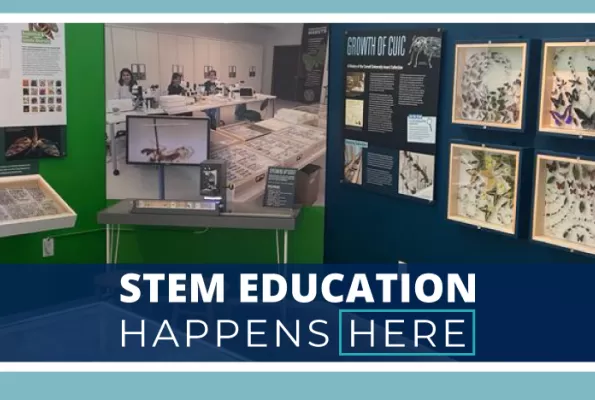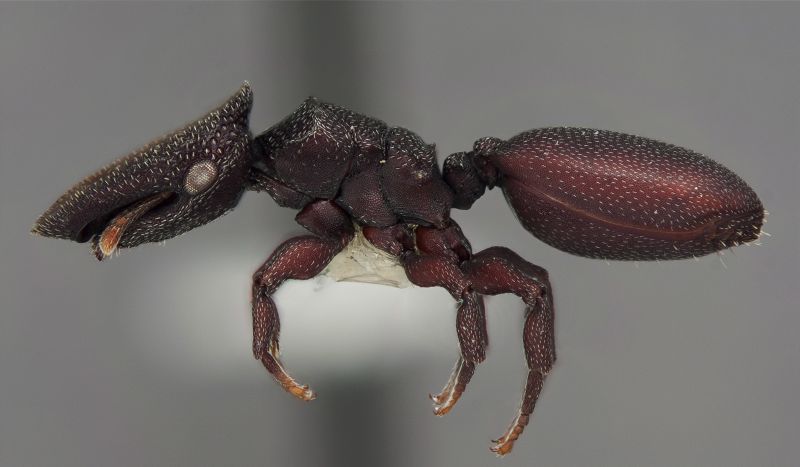
Unsung insect heroes
'Six-Legged Science' exhibit highlights the insects that keep humans and the planet humming
The bee at the window, the ants on the porch, the beetle on the floor, the spider in the corner – they're all part of a vast underworld of insects that sustains the Earth and the humans that inhabit it. And they're woefully underappreciated.
That's the theme behind "Six-Legged Science: Unlocking the Secrets of the Insect World," an interactive exhibit of more than 1,000 specimens at the Museum of the Earth in Ithaca, New York. The goal of the exhibit, powered in part by the U.S. National Science Foundation, is to educate the public about the critical role that insects play as pollinators, foundational food sources, scavengers and decomposers in keeping ecosystems humming.
The brainchild and driving force behind the exhibit is Corrie Moreau, an evolutionary biologist and entomologist and the director and curator of the Cornell University Insect Collection, CUIC, in the Department of Entomology, which partnered with the Museum of the Earth and loaned specimens from its vast 7 million-plus, world-class collection.
When it comes to insects, Moreau is their lifelong and enthusiastic goodwill ambassador.
"Insects are the unsung heroes of the animal world," Moreau said. "They're the base of almost every ecosystem. If all the insects were to disappear, pretty much life on the planet would be inhospitable for most terrestrial vertebrates, including us in, I would say, under three months."
NSF Program Director and biologist Jodie Jawor said the exhibit plays an important role in educating the public on the symbiotic relationship between humans and insects and what will be lost if that relationship frays.
"It's incredibly important to understanding what insects do for us as humans and for other species on the planet," Jawor said. "But also, what does it mean as we lose an insect species or a species invades a range that it's never been in before and interacts with native insects. What could we lose when that happens?"
According to a study that appeared in the February 2020 issue of the peer-reviewed journal Biological Conservation, there are an estimated 5.5 million insect species in the world, but only a fifth of them are named. Up to half-a-million insect species have gone extinct since the Industrial Age began, and another half-a-million face extinction in the coming decades. Drivers of extinction include habitat loss and fragmentation, use of polluting and harmful substances, the spread of invasive species, global climate change and overexploitation.
'I'll hold that hissing cockroach now'
NSF has been integral to many of Moreau's research projects, both at Cornell and when she was associate curator in the Division of Insects at The Field Museum in Chicago. It was research into her favorite insect – Florida turtle ants – that inspired the "Six-Legged Science" exhibit.
"They are phenomenal animals," Moreau said of the ants. "Not only are they structurally very beautiful; they look like little tanks. They're called turtle ants because when they get frightened or if they're worried about being injured, they pull their legs and antennae in like a little turtle. And the soldiers have these dish-plate heads that they use to block the nest entrance they live in. The nest entrance is exactly the same size as the dish plate, so she just sits there blocking the nest entrance all day and only moves out of the way for other members of the colony, her sisters. So her defense is just literally being a living door."
It's telling details like these that Moreau believes engage the public, educate them and dispel unwarranted fears.
Part of her grant to study turtle ants was used to build the "Six-Legged Science" exhibit. Since it opened in late March, she said, tens of thousands of people have visited. They can view and read about a broad range of specimens, both living and pinned; check out entomological field tools, insect nests and blow-up graphics that show bugs up close; and explore an actual CUIC specimen cabinet. During special events, visitors can even handle live specimens.
"I've had many situations where people are terrified of insects, and then you talk to them and it's like, 'OK, I'll hold that hissing cockroach now,'" Moreau said.
"Things like these museum exhibits," Jawor said, "they can really make a difference in helping people see something that they feel afraid of or even repulsed by and see that they do have a very important benefit to us and to the planet, and maybe we shouldn't just be wholesale destroying every spider we see."
Assisting in building the exhibit were Jason Dombroskie, CUIC coordinator and manager of the Insect Diagnostic Lab, and various CUIC students and researchers. It's set to run through the end of the year.




